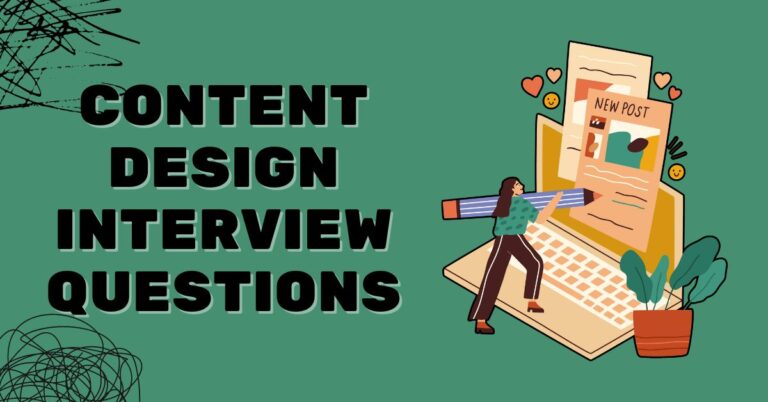30 Conversion Rate Optimization Interview Questions [ANSWERED]
Preparing for a Conversion Rate Optimization (CRO) interview can be a bit overwhelming.
You’re probably trying to figure out how to highlight your skills and knowledge in a way that really clicks with your potential employer.
The key is to keep things clear and focused—show how your expertise can make a real impact and drive results.
This guide will give you straightforward tips to confidently showcase your abilities in your upcoming interview.
What Questions Are Asked in a Conversion Rate Optimization Interview?
Check out the questions we’ve prepared for you below. Ranging from beginner to expert levels, we’ve ensured that you’ll cover the questions hiring managers might ask you as a CRO expert.
1. What is Conversion Rate Optimization (CRO)?
Interviewers ask this question to assess a candidate’s fundamental understanding of CRO. It tests whether the candidate comprehends the strategic importance of optimizing a website to enhance the percentage of visitors who complete a desired action.
Example Answer
“Conversion Rate Optimization (CRO) is the process aimed at increasing the percentage of visitors to a website who take a desired action, such as making a purchase or filling out a form. This involves understanding user behavior, leveraging analytics, and making data-driven decisions to improve the user experience and maximize conversions.”
2. Describe a simple CRO tool you have used.
They’re curious about your hands-on experience with CRO tools. This helps them understand not only if you know the theory but also if you’ve actually used the tools that help improve a website.
Example Answer
“I have used Hotjar, a tool that provides heatmaps, session recordings, and surveys. It helps understand how users interact with a website, which areas they focus on, and where they face issues. This insight allows for targeted improvements, such as optimizing page layout and enhancing user navigation.”
3. What factors can affect the conversion rate on a website?
They want to see if you know what can make or break a website’s ability to persuade visitors to take action. It’s about understanding both the obvious and subtle things that can influence visitor behavior.
Example Answer
“Several factors can affect website conversion rates, including page load speed, website navigation, content quality, CTA visibility, and overall user experience. External factors like market competition and target audience characteristics also play significant roles.”
4. Can you explain the concept of A/B testing?
A/B testing is a bread-and-butter skill in CRO. They want to make sure you can handle one of the most effective tools for improving a website.
Example Answer
“A/B testing involves comparing two versions of a webpage to see which performs better in terms of converting visitors. For example, you might test two different headlines or call-to-actions by showing the variants to similar visitors at the same time. The version that gives a higher conversion rate is then used moving forward.”
5. What is a conversion goal and how do you set one?
Setting clear goals is critical for any marketing strategy, including CRO. They need to know if you can pinpoint and set these goals based on what’s important for the business.
Example Answer
“A conversion goal is a specific action you want website visitors to take, like signing up for a newsletter or purchasing a product. To set this, you first identify key business objectives, then define measurable actions that align with these objectives. For instance, if the objective is to increase newsletter signups, the conversion goal would be the percentage of visitors who sign up.”
6. Give an example of a change you’ve made based on user feedback.
They’re really trying to see if you’re the type who listens and adapts. It’s all about whether you can take constructive criticism and use it to make something better. Everyone has ideas, but hearing from actual users and tweaking your project based on their needs? That’s where the magic happens.
Example Answer
“In my previous role, we received consistent user feedback that our mobile app checkout process was too complicated, leading to a high cart abandonment rate. Based on this feedback, I led a project to simplify the process. We reduced the number of steps from five to three and introduced a more intuitive interface with clearer instructions. As a result, we saw a 25% decrease in abandonment and a 15% increase in overall conversions. This improvement was directly attributed to our response to user feedback, highlighting our commitment to enhancing user experience based on real customer insights.”
7. What are some key performance indicators for CRO?
Curiosity about which KPIs you watch is their way of figuring out how you measure success. They want to know if you’re just about page views or if you’re really looking at the metrics that tell you whether you’re making a real impact—like, are you actually getting more people to do what you want them to do on the site?
Example Answer
“Key performance indicators for CRO focus on measuring the effectiveness of conversion-related activities. These include the conversion rate, which is the percentage of visitors completing a desired action; bounce rate, which reflects the percentage of visitors leaving after viewing only one page; and average session duration, which provides insight into how long visitors are engaged with the content.
Additionally, I monitor the click-through rate on key pages and the abandonment rate in the checkout process for e-commerce platforms. Each of these KPIs provides valuable insights into user behavior and the effectiveness of specific optimization strategies.”
8. How would you use data to suggest a website change?
They want to see if you can back up your gut feelings with hard facts. It’s great to have instincts, but in CRO, being able to look at the numbers and say “Here’s exactly why we need to make this change” is what sets the pros apart.
Example Answer
“To recommend a website change, I first gather and analyze data from a variety of sources including web analytics, heatmaps, and user behavior patterns.
For example, if the data reveals a high drop-off rate on a specific landing page, I would dive deeper to understand the elements contributing to user exit. Using tools like Google Analytics for quantitative data and Hotjar for qualitative insights, such as session recordings and heatmaps, I would identify pain points like confusing navigation or ineffective call-to-actions.
Based on these findings, I would propose specific changes aimed at reducing friction and enhancing the user journey, supported by data to justify the recommended updates.”
9. What are heatmaps and how do they assist in CRO?
They’re checking if you know your tools and how to use them. Heatmaps aren’t just pretty pictures; they can tell you a lot about how people interact with your site, and interviewers want to know if you get how to translate those colorful blobs into actionable insights.
Example Answer
“Heatmaps are graphical representations of data where values are depicted by color. They are extremely useful in CRO as they visually display where users most frequently click, scroll, and move within a webpage.
This allows us to understand user behavior at a glance and identify areas of the page that attract the most attention or are being ignored.
For instance, a heatmap can show if users are failing to scroll to important content below the fold, which might indicate the need for design changes to improve content visibility and user engagement.”
10. How do you prioritize which pages to optimize first?
They want to know if you’ve got a strategy or if you just wing it. Prioritizing pages means you need to understand business goals, user behavior, and potentially, where you can get the biggest bang for your buck. It’s strategic thinking they’re after.
Example Answer
“Prioritizing pages for optimization involves assessing their impact on the business goals and their current performance.
I start by identifying high-traffic pages using analytics tools, as these represent the biggest opportunities for quick wins. Then, I assess the conversion rates of these pages to pinpoint underperforming areas.
Additionally, I consider the importance of each page in the customer journey, prioritizing those that play a crucial role in conversion or retention. This systematic approach ensures that we focus our efforts on areas that can significantly impact overall business objectives and improve user experience.”
11. Walk me through a successful A/B test you conducted.
They’re curious about your hands-on experience with one of the most crucial tools in CRO—A/B testing. It shows if you can not only plan and run tests but also analyze the data to make informed decisions.
Example Answer
“In a previous role, we noticed that our product page had a lower-than-expected conversion rate. To address this, I designed an A/B test comparing two different layouts: the original and a version where we simplified the information and made the purchase button more prominent.
We ran the test for a month, ensuring statistical significance by including thousands of sessions. The modified layout increased conversions by 18%.
This test was successful because it was based on clear hypotheses and followed rigorous statistical methods, resulting in actionable insights that significantly boosted our sales.”
12. What testing tools do you prefer for CRO and why?
They want to gauge your familiarity with the tools of the trade and understand your rationale for choosing certain tools over others, which can reveal a lot about your approach to CRO.
Example Answer
“My preferred tools for CRO are Google Optimize and Optimizely. Google Optimize integrates seamlessly with Google Analytics, which allows for precise targeting and tracking based on existing analytics data.
This integration is invaluable for quickly implementing and measuring tests. Optimizely, on the other hand, offers more advanced features like multivariate testing and audience segmentation, which are crucial for running more complex experiments on larger sites.
Both tools offer robust functionalities that help streamline the testing process, from hypothesis creation to final analysis.”
13. How do you identify barriers to conversion and overcome them?
This question tests your problem-solving skills and your ability to diagnose and fix issues that prevent users from converting. It’s about understanding how you approach challenges and find solutions.
Example Answer
“Identifying barriers to conversion starts with data analysis, using tools like Google Analytics to pinpoint where drop-offs occur in the conversion funnel.
For example, if we see a high exit rate from the checkout page, I conduct further analysis using session replay tools like FullStory to watch user interactions and identify specific pain points, such as confusing form fields or unexpected shipping costs.
To overcome these barriers, I would streamline the checkout process, provide clearer information, and possibly introduce a progress indicator to keep users engaged through completion.”
14. Describe how you collaborate with design and development teams.
This question explores your ability to work effectively in a team setting, particularly how you communicate and cooperate with other departments to implement CRO initiatives.
Example Answer
“Collaboration with design and development teams is essential for successful CRO. I start by sharing the data and insights that highlight areas for improvement.
For instance, if testing indicates that a new button placement could increase conversions, I’ll discuss this with the design team to explore creative solutions, and then work with developers to implement changes in a test environment.
Regular meetings and using project management tools like Jira help keep everyone on the same page and ensure that implementations are done correctly and timely.”
15. What strategies do you use to identify conversion issues on landing pages?
They’re testing your analytical skills and your ability to use data to pinpoint problems. It’s about how methodically you can dissect a landing page to find what’s working and what isn’t.
Example Answer
“To identify conversion issues on landing pages, I use a combination of quantitative and qualitative data.
I start with analytics to understand traffic patterns and engagement metrics, such as bounce rates and time on page. I complement this with heatmaps and user recordings to visualize user interaction and identify areas where users seem confused or disengaged.
This dual approach allows me to pinpoint specific elements—like unclear calls-to-action or poorly placed content—that may be hindering conversions.
Based on these insights, I propose and test changes aimed at resolving these issues, continuously iterating based on user feedback and further testing.”
16. How do you measure the success of a CRO campaign?
They’re digging into how you track and evaluate your work. It’s not just about making changes; it’s about knowing whether those changes actually made things better. Can you prove that what you’re doing is working?
Example Answer
“The success of a CRO campaign is measured by how well it meets predefined objectives using specific key performance indicators (KPIs).
Typically, these include an increase in conversion rates, improvement in customer engagement metrics such as time on page and bounce rate, and ultimately, a boost in revenue.
For instance, if the goal was to increase newsletter sign-ups, I’d look at the conversion rate before and after implementing changes.
Additionally, I use A/B testing results to compare performance between different versions of a page, ensuring that we’re making data-backed decisions that align with our business goals.”
17. Discuss a time when you had to adjust your strategy based on data.
They want to know if you can pivot and adapt. Things don’t always go as planned, and data doesn’t always tell you what you expect. Can you shift gears and find a new path forward when needed?
Example Answer
“In a previous role, we launched a redesigned product page intended to increase sales. Initially, data showed a decrease in conversions, contrary to our expectations.
Upon analyzing user behavior data and feedback, we discovered that users found the new design cluttered and confusing.
I led a rapid response to simplify the design and enhance clarity, focusing on larger images and more prominent product benefits. We retested and observed a 30% improvement in conversion rates.
This experience underscored the importance of being flexible and responsive to data, rather than rigidly adhering to an initial strategy.”
18. What common mistakes should be avoided in CRO?
It’s a check on your expertise and your ability to learn from common pitfalls in the field. Can you foresee potential roadblocks and steer clear of them?
Example Answer
“Common mistakes in CRO include not allowing enough time for tests to reach statistical significance, leading to decisions based on incomplete data.
Another frequent error is not segmenting the data properly, which can mask how different groups react differently to the same changes.
Additionally, it’s crucial to avoid making too many changes at once without testing, as this can make it difficult to pinpoint which change impacted the results.
Focusing on best practices and ongoing learning helps avoid these issues and drives more reliable outcomes.”
19. How do you handle mobile vs. desktop optimization?
They’re checking if you understand that users behave differently depending on their device. It’s about ensuring you can tailor strategies to meet users where they are—on their phones or at their desks.
Example Answer
“Mobile and desktop optimization require distinct strategies due to differing user behaviors and screen sizes.
For mobile, I focus on optimizing for speed and ease of navigation, ensuring buttons and text are sized for smaller screens. For desktop, I can leverage larger displays for more detailed content and complex interactions.
Using responsive design techniques is crucial, alongside device-specific adjustments based on analytics data that highlights device-specific user behaviors and conversion rates.”
20. Describe a challenging CRO project and how you overcame it.
They want to hear about your problem-solving skills under pressure. What do you do when the going gets tough? This tells them about your resilience and creativity in tough situations.
Example Answer
“One challenging project involved optimizing the conversion rate for a high-traffic e-commerce site that suddenly experienced a drop in sales.
After a thorough data analysis, we identified that a recent update had unintentionally increased the page load time, particularly impacting mobile users. My team prioritized performance enhancements, optimized images, and streamlined the checkout process.
We conducted phased rollouts to monitor impact carefully. Within a month, we restored the conversion rate to its previous level and ultimately improved it by an additional 10% through further tweaks based on user feedback and iterative testing.
This project taught me the importance of vigilance in monitoring performance metrics and the effectiveness of a responsive, iterative approach in CRO.”
ALSO READ: What are the Best CRO Projects to Do Right Now?
21. Can you outline the process of developing a comprehensive CRO strategy?
They want to see if you can think big picture. Developing a comprehensive CRO strategy shows that you can take charge of a project from start to finish, considering all aspects from initial research to final optimizations.
Example Answer
“Developing a comprehensive CRO strategy begins with defining clear, measurable objectives aligned with business goals.
The next step involves detailed data analysis to understand current performance and identify areas for improvement. This includes analyzing traffic sources, user behavior, and conversion funnels.
Based on this analysis, I develop a hypothesis for what changes could lead to improvement and prioritize these based on expected impact and ease of implementation. This is followed by designing and running A/B tests to validate these hypotheses.
The strategy is continuously refined based on test results and further analysis, ensuring ongoing improvement and adaptation to changing user behavior and market conditions.”
22. How do you use advanced analytics to drive conversion improvements?
It’s crucial to know how you handle data. Advanced analytics can provide deep insights into user behavior, and they want to know if you can translate complex data into actionable strategies.
Example Answer
“I leverage advanced analytics to identify patterns and trends that indicate opportunities for conversion improvements.
This involves using segmentation to break down data by user demographics, behavior, and acquisition channels to understand different user journeys and pain points. I employ predictive analytics to forecast trends and model potential changes to the user experience. Tools like SQL for data querying,
Python for data manipulation and analysis, and platforms like Tableau for visualizing data help in drawing actionable insights that guide strategic decisions to optimize conversion rates.”
23. What innovative methods have you employed to reduce cart abandonment?
They’re looking for creativity and your ability to solve common e-commerce problems in innovative ways. Cart abandonment is a major issue, and unique solutions can significantly boost sales.
Example Answer
“To reduce cart abandonment, I implemented a multi-pronged strategy focusing on both preemptive and reactive measures.
Preemptively, I introduced exit-intent pop-ups that offered a time-sensitive discount to users showing signs of leaving a filled cart. Reactively, I set up an email retargeting campaign that reminded users of their abandoned carts and provided personalized product recommendations.
Additionally, I simplified the checkout process by reducing the number of required fields and adding multiple payment options, including popular mobile payment systems, which catered to a broader range of customer preferences.”
24. Discuss how you integrate qualitative and quantitative research in your projects.
This question tests your ability to blend different types of data for a holistic approach to CRO. It’s crucial for understanding the full user experience beyond just numbers.
Example Answer
“Integrating qualitative and quantitative research is essential for a well-rounded CRO strategy.
Quantitatively, I analyze data from Google Analytics for traffic patterns, conversion rates, and other metrics. Qualitatively, I gather insights through user interviews, surveys, and usability testing to understand the motives and opinions behind user behaviors.
This combined approach allows me to identify not only what is happening on the site but also why it’s happening.
For instance, if quantitative data shows a high drop-off rate at a form, qualitative insights from user testing might reveal that users find the form too intrusive or complicated, leading to targeted improvements.”
25. What are the most challenging aspects of CRO projects?
Understanding the challenges you’ve faced and overcome gives them insight into your problem-solving skills and resilience. CRO can be complex, and they need someone who can navigate those complexities effectively.
Example Answer
“One of the most challenging aspects of CRO projects is aligning multiple stakeholders with varying priorities around a unified strategy.
Additionally, continuously adapting to changing user behaviors and market trends requires agility and ongoing learning. Overcoming these challenges involves clear communication, regular stakeholder updates, and a flexible approach to strategy implementation.
It also entails staying updated with the latest CRO tools and techniques to ensure that the strategies implemented are state-of-the-art and based on the latest best practices.”
26. How do you ensure continual improvement in a CRO campaign?
They’re looking to see if you have a proactive approach to CRO, not just setting it and forgetting it. Continual improvement means you’re committed to constantly refining strategies to achieve better results over time.
Example Answer
“Continual improvement in a CRO campaign is ensured through an iterative process of testing, learning, and optimizing.
I start by setting clear, measurable goals and establish a baseline with existing data. From there, I implement A/B testing and multivariate testing to experiment with different approaches.
By analyzing the outcomes and gathering user feedback, I identify what works and what doesn’t. This cycle of testing, measuring, and refining continues throughout the campaign, ensuring that we are always moving towards better conversion rates.
Additionally, staying abreast of new tools and techniques in the market is crucial for adapting and improving strategies continually.”
27. How many experiments do you typically run per month, and why?
They want to gauge your productivity and your strategic approach to experimentation. This question also helps them understand how you manage resources and timelines in a dynamic environment.
Example Answer
“The number of experiments I run per month varies depending on the specific goals of the campaign and the capacity of the website traffic to support meaningful results.
Typically, I aim to run between three to five experiments per month. This number allows for sufficient time to design thoughtful experiments, gather enough data for statistically significant results, and analyze findings without rushing the process.
It balances the need for thorough testing with the necessity of maintaining a dynamic, responsive CRO strategy.”
28. Describe an experiment that did not go as planned and how you handled it.
This question tests your ability to handle setbacks and learn from failure, which are essential qualities in the ever-evolving field of CRO.
Example Answer
“In one notable experiment, we tested a new checkout process intended to simplify user flow but observed an unexpected drop in conversions.
Upon reviewing the analytics, we realized that while the new process was shorter, it lacked clear visual cues that helped guide users through each step, causing confusion.
We quickly adjusted the experiment by reintroducing some of these visual elements in a more streamlined form and resumed the test.
The adjusted version led to a 10% increase in checkout completions, demonstrating the importance of adaptability and the willingness to quickly respond to unexpected results.”
29. What guarantees can you offer about your CRO services?
They want to understand your confidence in your abilities and your ethical stance on guaranteeing results in a field as variable as CRO.
Example Answer
“While it’s unethical to guarantee specific results in CRO, given the myriad of external variables that can impact outcomes, I can assure you of a commitment to applying best practices, continuous learning, and a data-driven approach.
My focus is on delivering sustained improvement in your metrics through meticulous testing, accurate analysis, and strategic optimizations.
I guarantee transparency in processes and communications, with regular reporting on campaign performance and strategic adjustments based on data insights.”
30. How do you educate and align stakeholders on CRO efforts?
They’re checking if you can communicate effectively with different stakeholders, often with varying levels of understanding about CRO, to ensure everyone is on the same page.
Example Answer
“Educating and aligning stakeholders involves clear, consistent communication tailored to the audience’s level of expertise.
I regularly schedule meetings to discuss progress, challenges, and results. For more technical aspects, I provide simplified explanations and visual presentations to make the data accessible and understandable.
I also share case studies and examples of successful strategies to demonstrate the potential impact of CRO efforts.
By keeping stakeholders informed and involved in the decision-making process, I ensure that there is broad support for CRO initiatives and a shared understanding of their value to the business.”
How to Ace Your Conversion Rate Optimization Interview
Understand the Importance of Data in CRO
Employers in a CRO interview are keen to assess your capability with data because it’s the backbone of effective decision-making in CRO. Discuss how you employ analytics tools like Google Analytics or Hotjar to pull actionable insights that have previously guided optimization strategies. Give examples where your data-driven decisions resulted in measurable improvements, demonstrating both your technical and strategic application of data.
Demonstrate Your Problem-Solving Skills
CRO challenges require keen problem-solving skills, which you can showcase by discussing how you’ve tackled significant conversion issues. Describe a specific problem, the analytical approach you used to address it, the solutions you implemented, and the results of those actions. This will highlight your critical thinking and your ability to translate problems into positive outcomes.
Highlight Your Ability to Adapt and Learn
The digital marketing landscape, especially in CRO, is ever-evolving; thus, adaptability is crucial. Share instances where you adapted your strategies in response to new data or shifts in market dynamics. Mention how you keep yourself updated with the latest CRO trends and practices, underscoring your commitment to continual learning and improvement.
Discuss Your Experience with A/B Testing
A/B testing is pivotal in CRO, and your familiarity with conducting and analyzing these tests is crucial. Talk about the A/B testing platforms you’ve used and walk through a specific test you managed. Detail what you aimed to learn, what the outcomes taught you, and how you applied these learnings to enhance conversion rates effectively.
Communicate Your Understanding of User Experience
Optimizing user experience is integral to successful CRO as it directly impacts user interaction and conversion. Explain your approach to enhancing user experience and provide examples where your interventions in UX led to improved conversion metrics. This not only shows your UX knowledge but also your practical skills in applying UX principles to boost business outcomes.
Explain How You Handle Stakeholder Engagement
CRO often involves various stakeholders, and your ability to manage and align them is key to your success. Discuss your methods for keeping stakeholders engaged, such as through regular updates and strategic presentations, and how you ensure their understanding and buy-in for your CRO initiatives.
Conclusion
Juan Remote Work is a platform that aims to help you secure that CRO position you’re after.
Topics such as ‘How to Get Clients as a Freelancer‘, ‘Brand Manager Interview Questions‘, and more might pique your interest. If so, then don’t hesitate to head on over to our blog.
With proper preparation, you can face your interview as a Conversion Rate Optimization Expert with ease.
We hope we’ve helped you with this topic, and if you have any other questions, just don’t hesitate to comment them down below.







